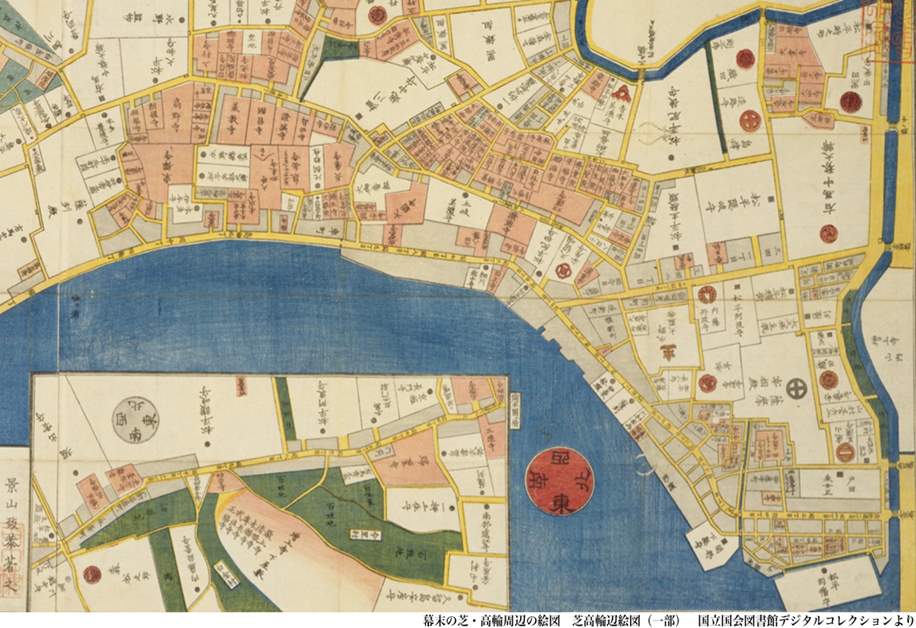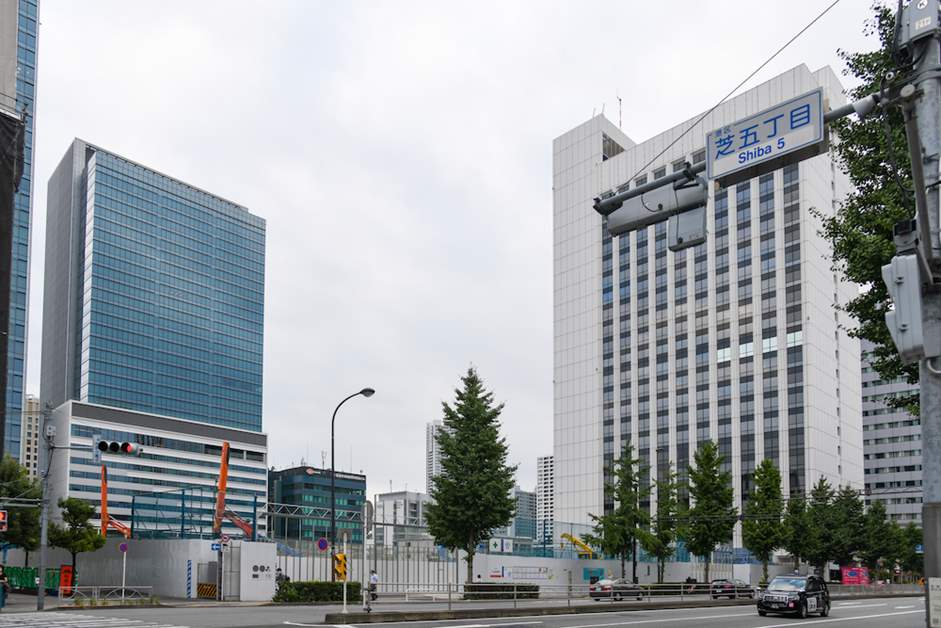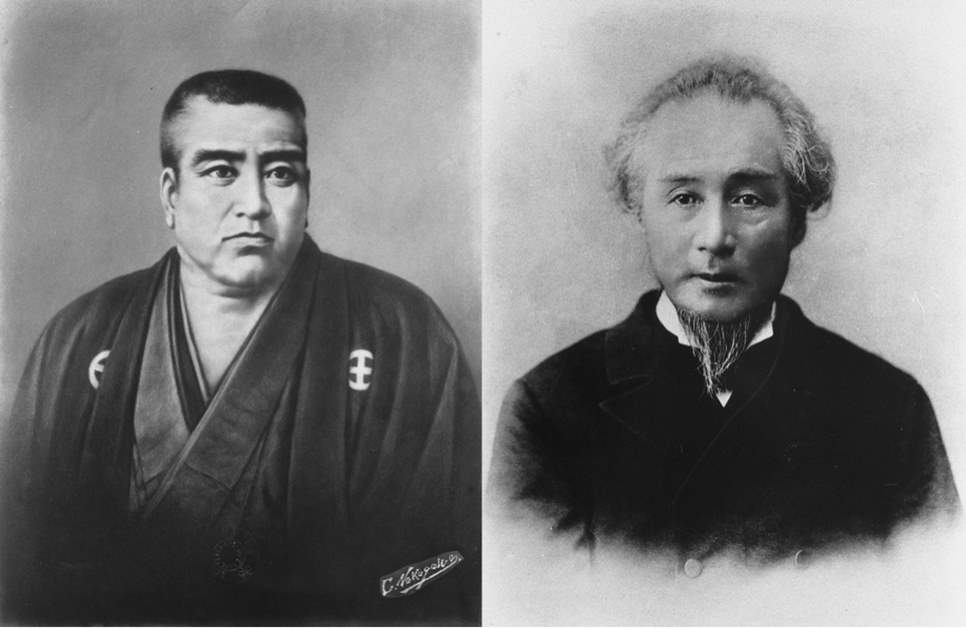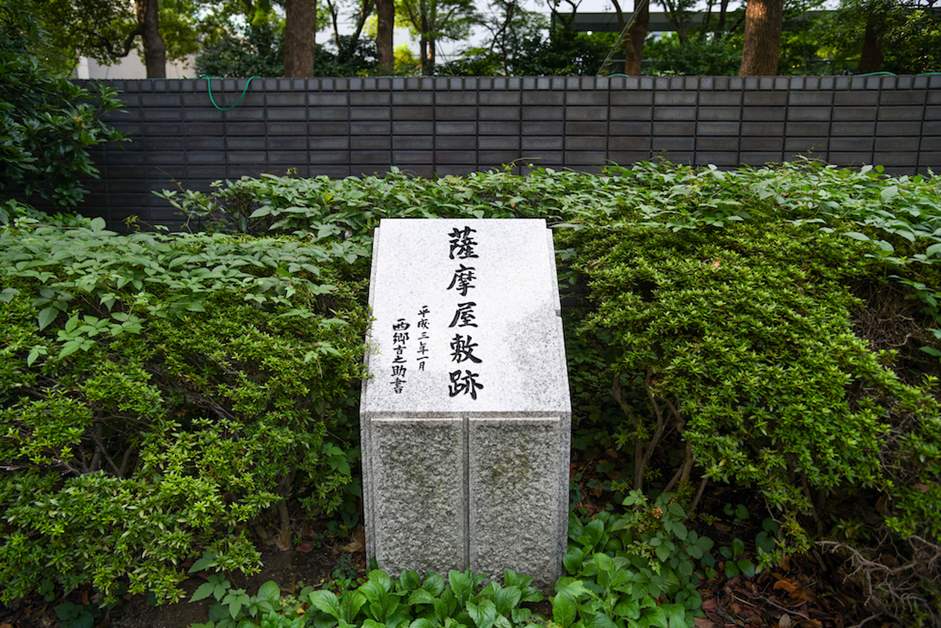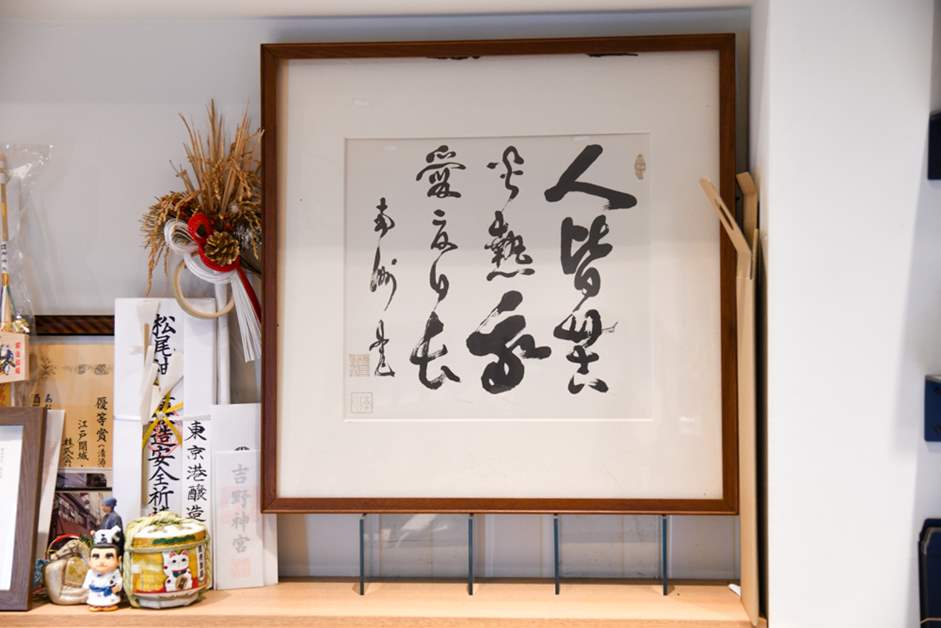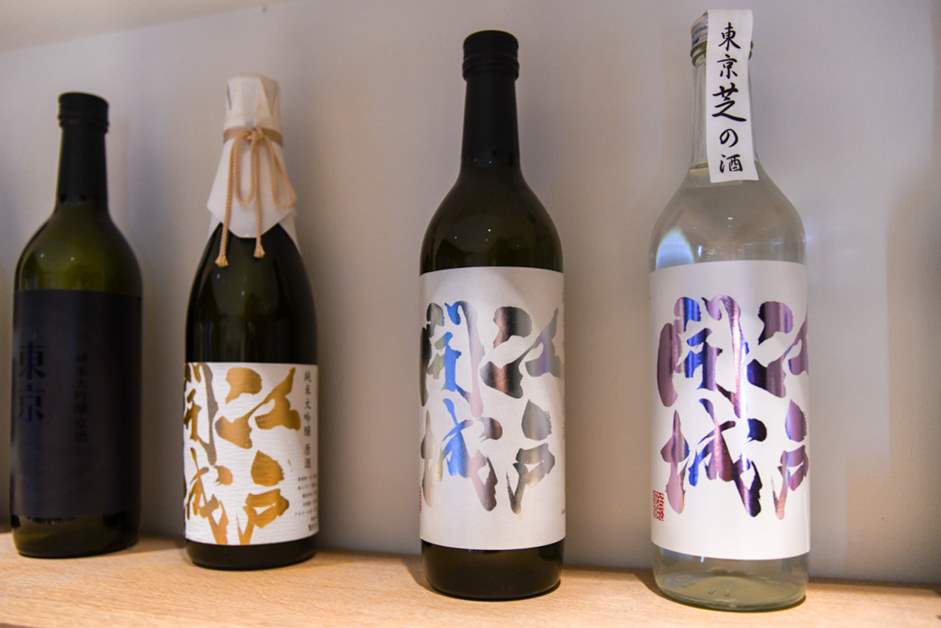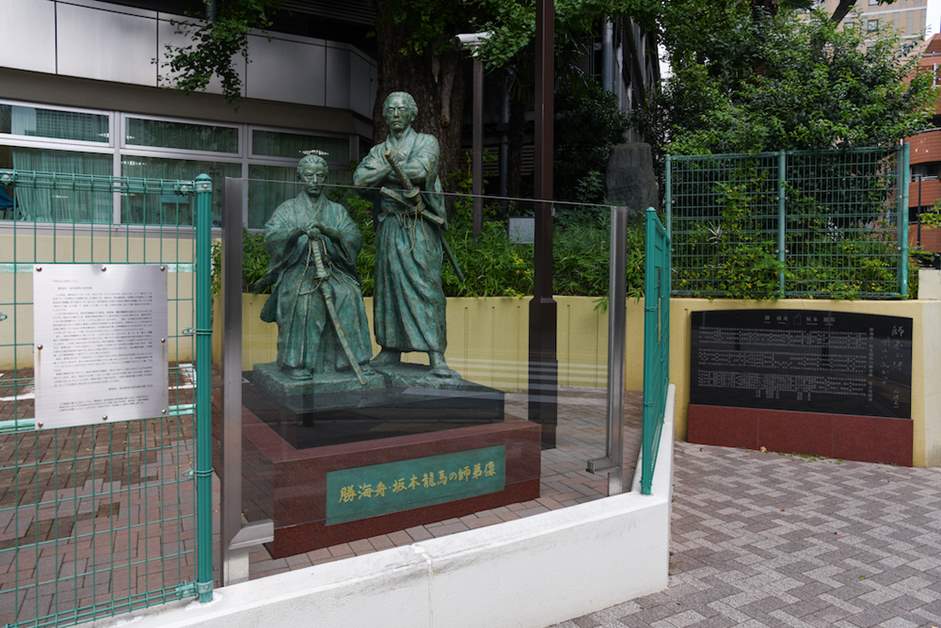Minato Ward, which was the stage for the Saigo Takamori and Katsu Kaishu talks that led to the "Edo Bloodless Opening"
Last year, Takanawa Gateway Station was opened as the first new station on the JR Yamanote Line in 49 years. The "gateway" of this station was named with the aim of making this area a hub for international exchange, but it also means that Takanawa will inherit the history of the time when it was once a bustling gateway to Edo. The current Minato Ward, where the residences of Takanawa and other clans were located, became the scene of numerous incidents from the early modern period to the modern era. Among them, the event that greatly changed the history of Japan was the meeting between Katsu Kaishu and Saigo Takamori, which led to the "bloodless opening of Edo" at the end of the Tokugawa shogunate. This time, let's take a look at one page of history while visiting the historical sites related to the meeting between the two.
At the Satsuma clan residence in Mita, you can see the two heroes of the end of the Edo period
It is about 1 km north of Daiichi Keihin from the "Takanawa Okido Ruins", which was once the gateway to Edo town. Just outside Exit A6 of Toei Subway Mita Station, there is a stone monument that says "Edo Kaijo Saigo Nanshu Katsu Kaishu Kainoji".
This is the place where the Satsuma Domain's storehouse was once located, and from March 13 of the 4th year of Keio (1868) to the next day, a meeting between Katsu Kaishu and Saigo Takamori was held, which led to the "Bloodless Opening of Edo". There is no vestige of the office buildings now, but the guide to the stone monument erected in Showa 27 (1952) says, "The back of this Kura-yashiki is a sandy beach facing the sea, and at that time, rice and other goods sent by ship from Satsuma Domain Kunimoto were landed here," which tells the story of when this area was still near the sea.
Why, then, did an important meeting take place here that would change the future of Japan?
The turbulent era at the end of the Edo period. Even after the momentum for the overthrow of the shogunate increased, and in the 3rd year of Keio (1867), the 15th Tokugawa shogun, Keiki, accepted the return of the Imperial Government, the new government, led by the Satsuma Domain, did not relent in its attack on the old shogunate. On the other hand, in Edo, the former shogunate camp burned down the Satsuma clan residence, and the conflict between the two armies deepened, leading to the Boshin War.
In January of the following year, Keio 4 (1868), the first battle of the "Battle of Toba-Fushimi" in Kyoto ended in victory for the new government forces, and Keiki, who was in Osaka at that time, hurriedly returned to Edo. After that, as if to besiege Edo, the army advanced from three directions: the Tokaido, the Nakasendo Highway, and the Koshu Highway.
After returning to Edo, Keiki left Edo Castle and took up residence at Kaneiji Temple in Ueno. While some vassals advocated an all-out war, Keiki, who had also expressed his intention to obey the imperial court in some quarters, entrusted the full power of the old shogunate to Okubo Kazuo and Katsu Kaishu, who had become acquainted with Saigo Takamori and other members of the new government army through the two conquests of Choshu from the first year of the Genji era (1864).
The turbulent era at the end of the Edo period. Even after the momentum for the overthrow of the shogunate increased, and in the 3rd year of Keio (1867), the 15th Tokugawa shogun, Keiki, accepted the return of the Imperial Government, the new government, led by the Satsuma Domain, did not relent in its attack on the old shogunate. On the other hand, in Edo, the former shogunate camp burned down the Satsuma clan residence, and the conflict between the two armies deepened, leading to the Boshin War.
In January of the following year, Keio 4 (1868), the first battle of the "Battle of Toba-Fushimi" in Kyoto ended in victory for the new government forces, and Keiki, who was in Osaka at that time, hurriedly returned to Edo. After that, as if to besiege Edo, the army advanced from three directions: the Tokaido, the Nakasendo Highway, and the Koshu Highway.
After returning to Edo, Keiki left Edo Castle and took up residence at Kaneiji Temple in Ueno. While some vassals advocated an all-out war, Keiki, who had also expressed his intention to obey the imperial court in some quarters, entrusted the full power of the old shogunate to Okubo Kazuo and Katsu Kaishu, who had become acquainted with Saigo Takamori and other members of the new government army through the two conquests of Choshu from the first year of the Genji era (1864).
Left: Takamori Saigo Right: Kaishu Katsu
Later, Saigo, who was staying in Sunpu (present-day Shizuoka City) as the de facto commander of the new government army, came Yamaoka Tetsushu, who had been ordered by the old shogunate to act as a negotiator. At this meeting, Saigo presented seven conditions for the survival of Keiki and the Tokugawa family, including "entrusting Keiki's custody to the Bizen Domain (present-day Okayama Prefecture)," "surrendering Edo Castle," and "handing over weapons and warships." Upon hearing this, Yamaoka sets up a direct meeting with Katsu and Saigo. Originally, the new government forces had set March 15 as the start date for the general attack on Edo Castle, but two days before that, a meeting between the leaders of the two armies was realized.
Saigo and Katsu talking at the summit of Mt. Atago
Handing over Keiki's custody to Bizen, which was under the control of the new government, was synonymous with Keiki's seppuku, and for Katsu, that was the only thing that could be avoided at all costs. However, there is no detailed record of the meeting between the two that took place in secret, and it is not clear where and what kind of conversation took place. As for the place of the meeting, the Satsuma clan had an upper mansion in Mita and a lower mansion in Takanawa in addition to Tamachi, and in Katsu Kaishu's diary, there is a description that he went to the Satsuma domain residence in Takanawa . One theory is that a preliminary meeting was held at the Takanawa mansion on the first day, and a final meeting was held at the Tamachi mansion on the second day.
Monument of the ruins of the Satsuma clan Mita mansion on Shiba 5-chome
On the other hand, Mt. Atago, where Atago Shrine stands, is also said to be the place that Saigo and Katsu visited during their meeting. At that time, Mt. Atago, which was located on a small hill above sea level of 26 meters, overlooked the town of Edo and Shibaura. If you go up the men's slope of Atago Shrine, which is called the "stone steps of career" and look back, you will surely be able to imagine the scenery of the past, even if you can't see as much as you did back then.
In fact, Katsu was planning a scorched-earth strategy to burn down the city of Edo in preparation for the new government's army attacking the city. He wanted to burn the town to prevent the enemy from entering, and on the other hand, he wanted to invest his own money to get the citizens out of Edo.
Even if the scorched earth strategy was not carried out, Edo was still the largest city in the world at the time, with a population of more than 1.2 million. It was clear that a clash between the new government army, which had been emboldened by the victories at Toba and Fushimi, and the old shogunate army, which had an inferior but powerful naval force, would result in a large number of refugees, which was not convenient for the British, who supported the Satsuma clan and felt the trade importance of Edo. Scorched earth preparations and external pressure from Britain. Katsu, who had once traveled to the United States and learned Western negotiation skills, approached talks with Saigo from various angles and was committed to protecting the city of Edo. There are no reliable records, but I am sure that he saw the bustle of the town of Edo from the top of Mt. Atago, and persuaded Saigo to attack Edo Castle.
Thus, peace was concluded between the two sides, and a general attack on Edo by the new government forces was averted. Then, on April 11, about a month after the meeting between the two sides, Edo Castle was handed over to the new government, and a rare "bloodless opening" in world history was established without shedding a single drop of blood. If the city of Edo had been turned into a sea of fire due to the war, the development of the city, which would later be reborn as "Tokyo", might not have happened. The meeting between the two men, which took place in present-day Minato Ward, was one of the most important moments in Japan history.
There are other places related to Saigo and Katsu in Minato Ward
In addition, as a way to convey the connection between Saigo Takamori and Minato Ward, Saigo's handwritten calligraphy remains in Shiba's Tokyo Port Brewery.
A replica of Saigo's calligraphy seen at the store of Tokyo Port Brewery
The book, which reads, "We all love the long summer days when we suffer from the scorching heat" (modern translation: Everyone in the world suffers from the heat of summer, but I like the long summer days), is said to have been received from Saigo by Wakamatsuya, a sake brewery with the roots of Tokyo Port Brewing, as a substitute for rent.
Wakamatsuya was in the process of delivering sake to the mansion of the Satsuma Domain, and at that time, Wakamatsuya's back room, which was in a place where it was easy to escape to Edo Bay in case of emergency, became a place for secret talks between Saigo, Katsu Kaishu, Yamaoka Tetsushu, and others, who were the driving forces behind the bloodless opening of Edo Castle. The main brand of this brewery is called "Edo Kaijo". Even if you are not a history buff, it is a sake that you want to taste at least once.
In addition, on Akasaka 6-chome, there is the "Katsu Kaishu Residence Ruins" where Katsu Kaishu lived from the 6th year of Ansei (1859) to the first year of the Meiji era (1868), and in the same place stands the "Master and Disciple Statue of Katsu Kaishu and Sakamoto Ryoma" along with Sakamoto Ryoma, who was his first disciple.
Why don't you feel the feelings that the great people of Edo put into the city of Edo and tour the land where history is accumulated?
Why don't you feel the feelings that the great people of Edo put into the city of Edo and tour the land where history is accumulated?




